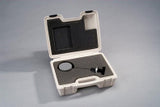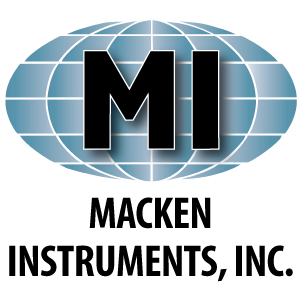Analog Laser Power Probe Specifications
|
Model |
Power Range |
Wavelength |
Damage |
Exposure Time |
Watts/ |
Absorbing Head |
Overall Length (cm) |
Weight (gm) |
Accuracy § |
Repeatability |
|---|---|---|---|---|---|---|---|---|---|---|
|
2-20W |
900-1250nm* |
3000W/cm2 |
30 sec. |
0.2 |
4.58 x 2.54 cm |
22 |
89 |
+/-5% |
+/-1.5% |
|
|
5-50W |
900-1250nm* |
3000W/cm2 |
20 sec. |
0.5 |
4.58 x 2.54 cm |
22 |
98 |
+/-5% |
+/-1.5% |
|
|
10-100W |
900-1250nm* |
3000W/cm2 |
20 sec. |
1 |
5.08 x 3.18 cm |
22 |
120 |
+/-5% |
+/-1.5% |
|
|
10-100W |
8µ - 11µ |
10,000W/cm2 |
20 sec. |
1 |
5.08 x 3.18 cm |
22 |
120 |
+/-5% |
+/-1.5% |
|
|
20-200W |
900-1250nm* |
2500W/cm2 |
20 sec. |
2 |
5.08 cm dia. |
22 |
157 |
+/-5% |
+/-1.5% |
|
|
20-200W |
8µ - 11µ |
7000W/cm2 |
20 sec. |
2 |
5.08 cm dia. |
22 |
157 |
+/-5% |
+/-1.5% |
|
|
50-500W |
900-1250nm* |
2000W/cm2 |
20 sec. |
5 |
5.08 cm dia. |
22 |
183 |
+/-5% |
+/-1.5% |
|
|
50-500W |
8µ - 11µ |
4000W/cm2 |
20 sec. |
5 |
5.08 cm dia. |
22 |
183 |
+/-5% |
+/-1.5% |
|
|
100-1000W |
900-1250nm* |
1750W/cm2 |
20 sec. |
10 |
6.35 cm dia. |
22 |
287 |
+/-5% |
+/-1.5% |
|
|
100-1000W |
8µ - 11µ |
2500W/cm2 |
20 sec. |
10 |
6.35 cm dia. |
22 |
287 |
+/-5% |
+/-1.5% |
|
|
200-2000W |
900-1250nm* |
1200W/cm2 |
20 sec. |
20 |
7.62 cm dia. |
22 |
522 |
+/-5% |
+/-1.5% |
|
|
200-2000W |
8µ - 11µ |
1500W/cm2 |
20 sec. |
20 |
7.62 cm dia. |
22 |
522 |
+/-5% |
+/-1.5% |
|
|
400-4000W |
900-1250nm* |
900W/cm2 |
20 sec. |
25 |
8.89 cm dia. x 4.6cm |
28 |
753 |
+/-5% |
+/-1.5% |
|
|
400-4000W |
8µ - 11µ |
1100W/cm2 |
20 sec. |
25 |
8.89 cm dia. |
28 |
753 |
+/-5% |
+/-1.5% |
|
|
500-5,000W |
900-1250nm* |
750W/cm2 |
20 sec. |
50 |
8.89 cm dia. x 5.6 cm |
28 |
1144 |
+/-5% |
+/-1.5% |
|
|
500-5,000W |
8µ - 11µ |
900W/cm2 |
20 sec. |
50 |
8.89 cm dia. |
28 |
1144 |
+/-5% |
+/-1.5% |
Y type probe wavelength range - These probes are calibrated at 8-11µ as well, but have a lower damage threshold for this range than the C type probes. Calibration for any wavelength between 250nm – 2500nm is available upon request with an NIST certificate.
Damage Threshold - Moving the probe during exposure will increase (up to double) the damage threshold compared to the numbers shown for a stationary probe. To achieve this increase, the head must be moved in a circular motion so that the laser beam does not strike any one area continuously for more than 1.5 seconds.
Accuracy and Exposure Time - The accuracy and repeatability of the Power Probes partly depends on the accuracy of the exposure time. The average accuracy of exposures (hand held) has been found to be 0.2 seconds. This amounts to a 1% error for a 20 second exposure time. Many lasers are equipped with a shutter that can produce an exact time exposure.
Power Probe Carrying Cases

